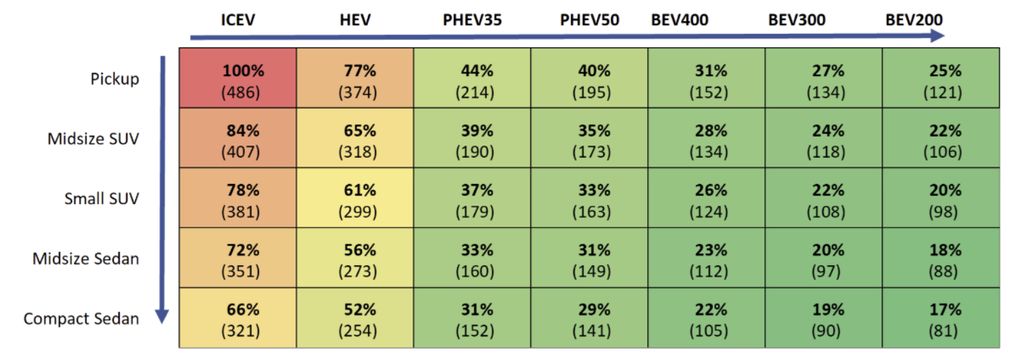- EVs are cleaner over the average vehicle lifetime in every county in the contiguous U.S., a new study confirms.
- They are cleaner even when accounting for battery production emissions, and regardless of whether your local electricity is renewable or comes from fossil fuels.
- Electrifying larger vehicles like pickup trucks would have the largest impact on the climate, the study shows.
It’s the most baffling argument I hear against EVs. I hear it from people who have never once demonstrated any concern for the environment who, suddenly spurred on by some podcast host or TikToker, proclaim that EVs are actually worse when you account for how dirty it is to make batteries and generate electricity.
That’s not true. It’s never really been true, it’s getting even less true over time and, a new study confirms, it isn’t true for any type of vehicle anywhere in the contiguous U.S.
Researchers at the University of Michigan studied the lifetime emissions of vehicles, including their production, tailpipe and other emissions sources to determine their overall impact on greenhouse gas pollution. They looked at internal-combustion engine (ICE) vehicles, plug-in hybrids and EVs over the average lifetime of a vehicle: 191,386 miles for sedans, 211,197 miles for SUVs and 244,179 miles for pickups, per the researchers.
How greenhouse gas emissions of different types of vehicles compare to those of a gas-powered pickup truck, according to University of Michigan research. Grams of carbon dioxide equivalent emitted per mile are listed in parentheses. Numbers after the powertrain abbreviation indicate the range. Image credit: E. Smith et al. Environ. Sci. Technol. 2025
Photo by: The University of Michigan
The study found what pretty much every study finds: EVs are far, far clearer than gas vehicles no matter how you slice it. And driving an EV reduces overall lifetime emissions, even when you account for manufacturing and electricity production. But the University of Michigan team also went far deeper than many cradle-to-grave analyses go, exploring how emissions stack up across several vehicle segments and powertrains—and how that changes in every county across the country.
(They even came up with this impressively detailed calculator, so you can see for yourself how switching to an electric pickup, crossover or sedan would cut your carbon footprint based on where you live.)

The Lucid Air is among the most efficient EVs you can buy in America.
Photo by: Lucid Motors
The researchers found that lifetime emissions for a battery electric vehicle (BEV) with a 300-mile range is 71-73% lower than a combustion vehicle on average, and that those benefits exist for every vehicle type. Compact electric sedans are the greenest cars, but the biggest gains would come from electrifying larger vehicles.
“Pickup trucks have the largest absolute benefit from electrification,” the study says, confirming that even the biggest electron-guzzling EVs are an environmental win. While smaller cars are cleaner in general, proponents sometimes imply that going smaller is more important than going electric. The authors disagree.
“Our analysis shows that powertrain electrification provides greater potential for life cycle emissions reductions compared to downsizing alone,” the study says. In other words, driving a hulking electric pickup truck is still generally better for the environment than choosing a petite, gas-powered sedan. This is not an efficient vehicle. But if you replace a gas hummer with an electric one, it’s still a big win for the climate. (An even bigger win would be getting a reasonably sized vehicle.) Photo by: General Motors
Importantly, the benefits of electrification exist in every segment and every part of the country the researchers studied. While some opponents argue that EVs are dirty if they’re recharged using power from fossil fuels, the facts say otherwise.
Generally, power plants are more efficient than cars, and a bunch of EVs charging from a natural gas plant are far cleaner than a bunch of gas vehicles independently producing tailpipe emissions, all of which more than offsets the extra environmental cost of making a battery. That’s why this study found that EVs are cleaner in every single county in the contiguous United States, even if they’re better in some markets than others.
“Regional variation has a minimal impact on comparisons of ICEV to HEV and PHEV to BEV,” the study says. BEVs are cleaner, regardless of where they’re charged. This is also due to the fact that—for an EV—producing the battery accounts for 48−56% of all of its lifetime emissions. For a gas car, 92% of the emissions come from driving it. Related Stories
Clearly, then, driving an EV is better. That’s doubly true if the car is purchased used an already exists, as its production costs are already baked in. The conclusion is the same advice I keep repeating: Get a gently used EV. You’ll end up with a car that will produce almost no meaningful emissions for the rest of its life, will last longer than you’ll want to keep it and that costs almost nothing to run.
If that’s not a recipe for the best car you’ll ever own, I don’t know what is.
Contact the author: Mack.Hogan@insideevs.com








